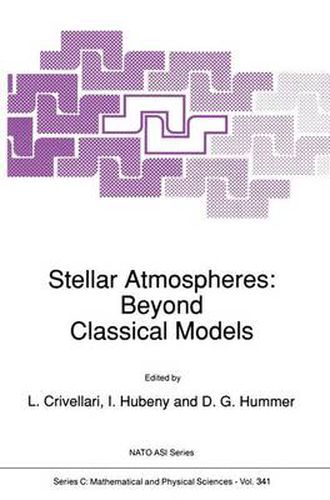Readings Newsletter
Become a Readings Member to make your shopping experience even easier.
Sign in or sign up for free!
You’re not far away from qualifying for FREE standard shipping within Australia
You’ve qualified for FREE standard shipping within Australia
The cart is loading…






This title is printed to order. This book may have been self-published. If so, we cannot guarantee the quality of the content. In the main most books will have gone through the editing process however some may not. We therefore suggest that you be aware of this before ordering this book. If in doubt check either the author or publisher’s details as we are unable to accept any returns unless they are faulty. Please contact us if you have any questions.
The theory of stellar atmospheres is one of the most important branches of modern astrophysics. It is first of all a major tool for understanding all aspects of stars. As the physical properties of their outer layers can now be found with high precision, firm conclusions can be drawn about the internal structure and evolution of stars. Moreover, improvements in our knowledge of the chemical composition of stars is shedding new light on the chemical evolution of galaxies and of the Universe as a whole. Because the outer layers of stars are among the best-understood astrophysical objects, the theory of stellar atmospheres plays an important role in the study of many other types of objects. These include planetary nebulae, H II regions, interstellar matter, and objects of interest in high-energy astrophysics, such as accretion disks (close binaries, dwarf novae, cataclysmic variables, quasars, active galactic nuclei), pulsar magnetospheres, and Seyfert galaxies. Finally, as stars provide a laboratory in which plasmas can be studied under more extreme conditions than on earth, the study of stellar atmospheres has strong connections with modern physics. Astronomical observations provided a vital stimulus in the early stages of quantum theory and atomic physics; even today topics such as low-temperature dielectronic recombination develop hand in hand with the interpretation of stellar and nebular spectra. Early work on MHD was similiarly motivated. Many such connections remain to be explored.
$9.00 standard shipping within Australia
FREE standard shipping within Australia for orders over $100.00
Express & International shipping calculated at checkout
This title is printed to order. This book may have been self-published. If so, we cannot guarantee the quality of the content. In the main most books will have gone through the editing process however some may not. We therefore suggest that you be aware of this before ordering this book. If in doubt check either the author or publisher’s details as we are unable to accept any returns unless they are faulty. Please contact us if you have any questions.
The theory of stellar atmospheres is one of the most important branches of modern astrophysics. It is first of all a major tool for understanding all aspects of stars. As the physical properties of their outer layers can now be found with high precision, firm conclusions can be drawn about the internal structure and evolution of stars. Moreover, improvements in our knowledge of the chemical composition of stars is shedding new light on the chemical evolution of galaxies and of the Universe as a whole. Because the outer layers of stars are among the best-understood astrophysical objects, the theory of stellar atmospheres plays an important role in the study of many other types of objects. These include planetary nebulae, H II regions, interstellar matter, and objects of interest in high-energy astrophysics, such as accretion disks (close binaries, dwarf novae, cataclysmic variables, quasars, active galactic nuclei), pulsar magnetospheres, and Seyfert galaxies. Finally, as stars provide a laboratory in which plasmas can be studied under more extreme conditions than on earth, the study of stellar atmospheres has strong connections with modern physics. Astronomical observations provided a vital stimulus in the early stages of quantum theory and atomic physics; even today topics such as low-temperature dielectronic recombination develop hand in hand with the interpretation of stellar and nebular spectra. Early work on MHD was similiarly motivated. Many such connections remain to be explored.